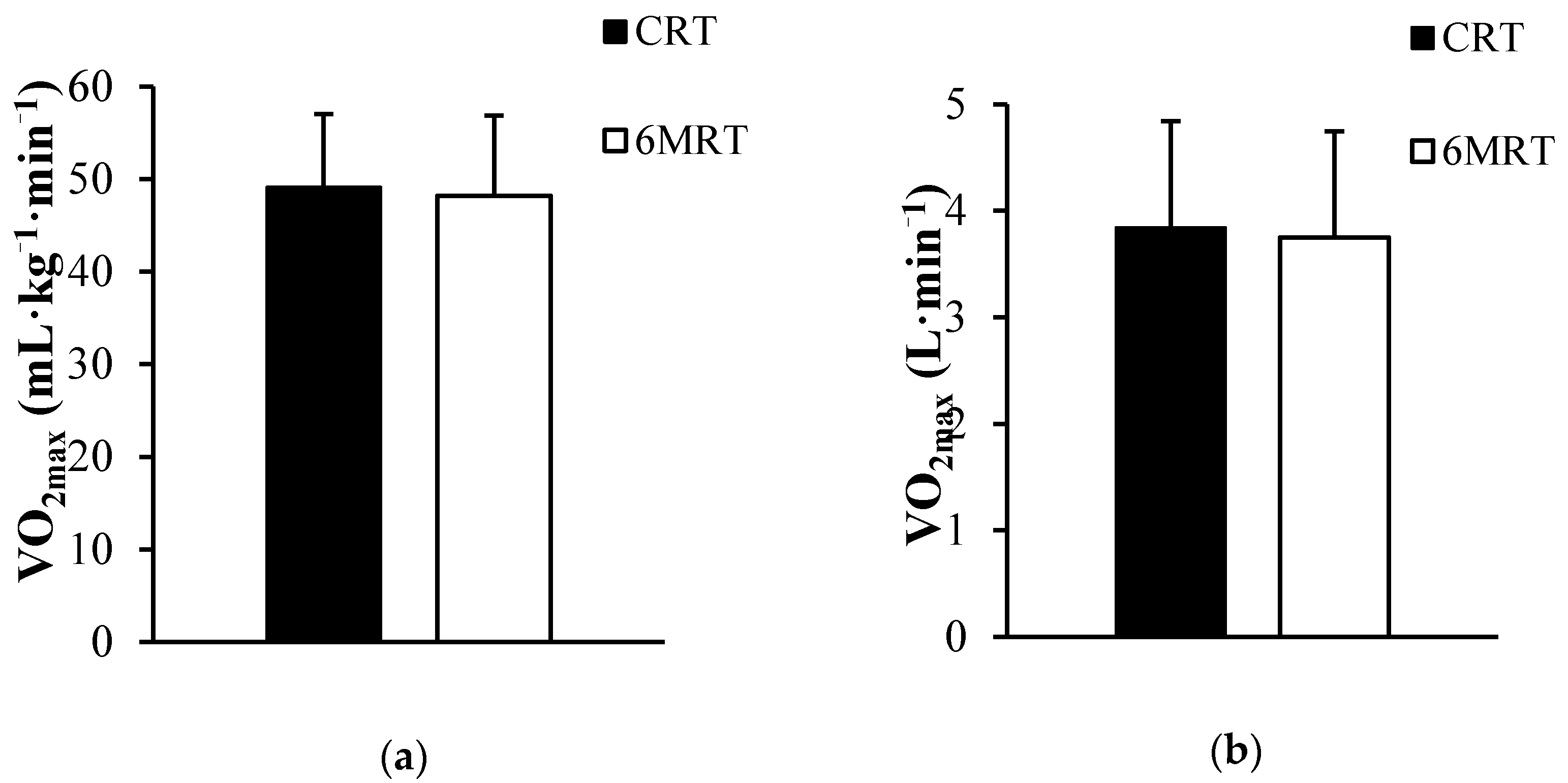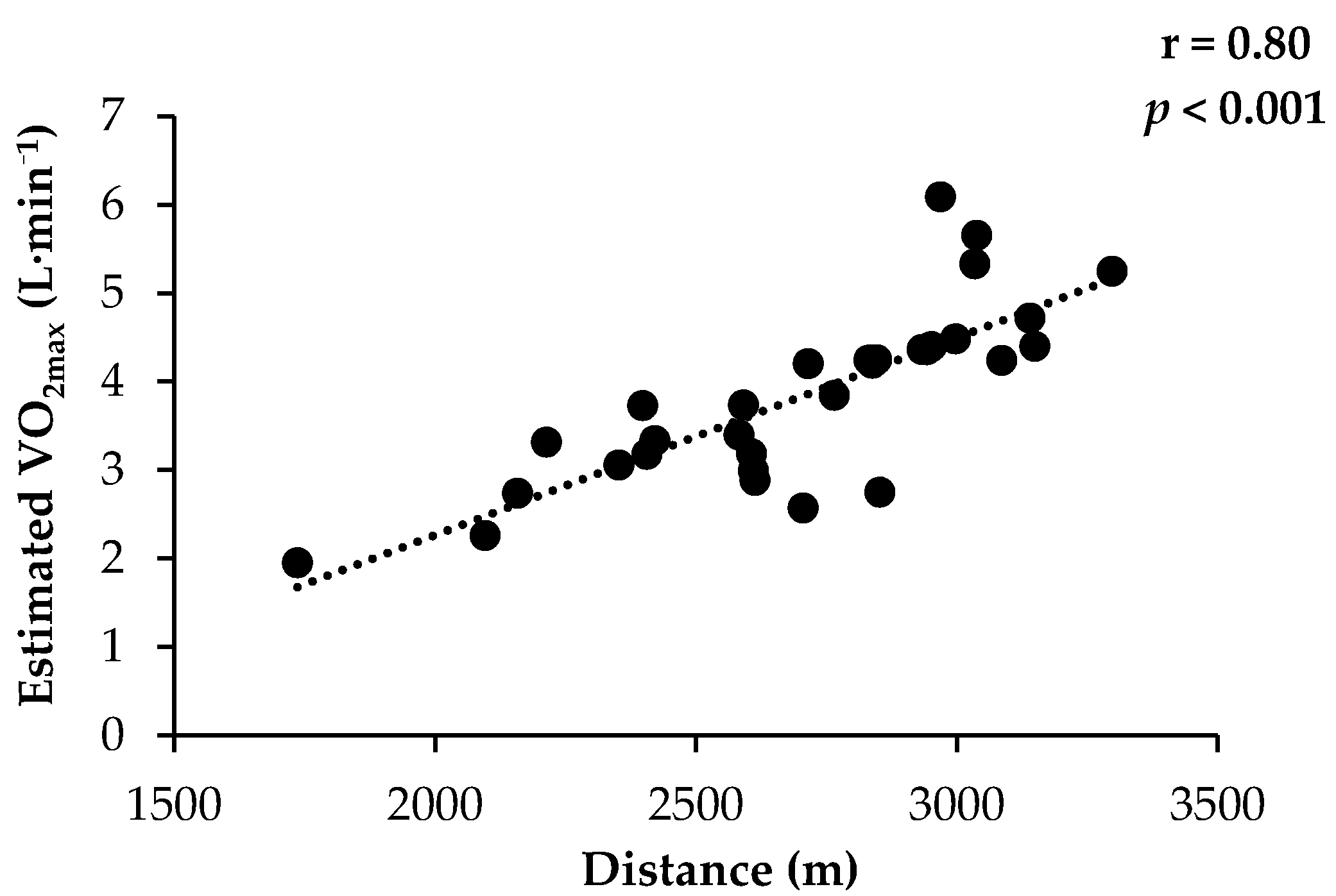Validation and Practical Applications of Performance in a 6-Min Rowing Test in the Danish Armed Forces
Abstract
1. Introduction
1.1. Preface
1.2. Background
1.3. Aims
2. Materials and Methods
2.1. Study Design
2.2. Subjects
2.3. Testing
2.3.1. Cooper’s 12-Min Run Test
2.3.2. 6-Min Rowing Test
2.4. Anthropometrics
2.5. Calculations
2.6. Statistics
3. Results
3.1. Maximal Oxygen Uptake
3.2. Comparison of Performance Characteristics Between Cooper’s 12-min Run Test and the 6-min Rowing Test
3.3. Test Performance Correlations
3.4. Test-Retest Comparisons of the 6-min Rowing Test
4. Discussions
5. Conclusions
Author Contributions
Funding
Institutional Review Board Statement
Informed Consent Statement
Data Availability Statement
Acknowledgments
Conflicts of Interest
References
- Gilchrist, J.; Jones, B.H.; Sleet, D.A.; Kimsey, C.D. Exercise-related injuries among women: Strategies for prevention from civilian and military studies. MMWR. Recomm. Rep. 2000, 49, 15–33. [Google Scholar]
- Rayson, M.; Holliman, D.; Belyavin, A. Development of physical selection procedures for the British Army. Phase 2: Relationship between physical performance tests and criterion tasks. Ergonomics 2000, 43, 73–105. [Google Scholar] [CrossRef] [PubMed]
- Santtila, M. Effects of Added Endurance or Strength Training on Cardiovascular and Neuromuscular Performance of Conscripts during the 8-Week Basic Training Period. Academic Dissertation, Faculty of Sport and Health Sciences, University of Jyväskylä. Stud. Sport Phys. Educ. Health 2010, 146, 9. [Google Scholar]
- Reilly, T. Canada’s physical fitness standard for the land force: A global comparison. Can. Army J. 2010, 13, 59–69. [Google Scholar]
- Andersen, A. (University of Aarhus, Aarhus, Denmark); Nielsen, A.H. (University of Southern Denmark, Odense, Denmark); Kilen, T.A. (University of Copenhagen, Copenhagen, Denmark and Center for Military Physical Training, Copenhagen, Denmark). Personal Communication, 2018.
- Bassett, D.R. Limiting factors for maximum oxygen uptake and determinants of endurance performance. Med. Sci. Sports Exerc. 2000, 32, 70–84. [Google Scholar] [CrossRef]
- Larsen, H.B.; Sheel, A.W. The Kenyan runners. Scand. J. Med. Sci. Sports 2015, 25, 110–118. [Google Scholar] [CrossRef] [PubMed]
- Nevill, A.M.; Allen, S.V.; Ingham, S.A. Modelling the determinants of 2000 m rowing ergometer performance: A proportional, curvilinear allometric approach. Scand. J. Med. Sci. Sports 2011, 21, 73–78. [Google Scholar] [CrossRef]
- Ingham, S.; Whyte, G.; Jones, K.; Nevill, A. Determinants of 2000 m rowing ergometer performance in elite rowers. Eur. J. Appl. Physiol. 2002, 88, 243–246. [Google Scholar] [CrossRef]
- Jensen, M.B.; Johansen, L.; Secher, N.H. Influence of body mass on maximal oxygen uptake: Effect of sample size. Graefe’s Arch. Clin. Exp. Ophthalmol. 2001, 84, 201–205. [Google Scholar] [CrossRef]
- Nevill, A.M.; Beech, C.; Holder, R.L.; Wyon, M. Scaling concept II rowing ergometer performance for differences in body mass to better reflect rowing in water. Scand. J. Med. Sci. Sports 2010, 20, 122–127. [Google Scholar] [CrossRef]
- Cureton, K.J.; Sparling, P.B.; Evans, B.W.; Johnson, S.M.; Kong, U.D.; Purvis, J.W. Effect of experimental alterations in excess weight on aerobic capacity and distance running performance. Med. Sci. Sports 1978, 10, 194–199. [Google Scholar] [PubMed]
- Sedeaud, A.; Marc, A.; Marck, A.; Dor, F.; Schipman, J.; Dorsey, M.; Haida, A.; Berthelot, G.; Toussaint, J.-F. BMI, a Performance Parameter for Speed Improvement. PLoS ONE 2014, 9, e90183. [Google Scholar] [CrossRef] [PubMed]
- Poole, D.C.; Jones, A.M. Measurement of the maximum oxygen uptake VO2max: VO2peak is no longer acceptable. J. Appl. Physiol. 2017, 122, 997–1002. [Google Scholar] [CrossRef]
- Helgerud, J.; Høydal, K.; Wang, E.; Karlsen, T.; Berg, P.; Bjerkaas, M.; Simonsen, T.; Helgesen, C.; Hjorth, N.; Bach, R.; et al. Aerobic High-Intensity Intervals Improve VO2max More Than Moderate Training. Med. Sci. Sports Exerc. 2007, 39, 665–671. [Google Scholar] [CrossRef]
- Cooper, K.H. A Means of Assessing Maximal Oxygen Intake. JAMA 1968, 203, 201–204. [Google Scholar] [CrossRef] [PubMed]
- McNaughton, L.; Hall, P.; Cooley, D. Validation of Several Methods of Estimating Maximal Oxygen Uptake in Young Men. Percept. Mot. Ski. 1998, 87, 575–584. [Google Scholar] [CrossRef]
- Penry, J.T.; Wilcox, A.R.; Yun, J. Validity and Reliability Analysis of Cooper’s 12-min Run and the Multistage Shuttle Run in Healthy Adults. J. Strength Cond. Res. 2011, 25, 597–605. [Google Scholar] [CrossRef]
- Mayorga-Vega, D.; Bocanegra-Parrilla, R.; Ornelas, M.; Viciana, J. Criterion-Related Validity of the Distance- and Time-Based Walk/Run Field Tests for Estimating Cardiorespiratory Fitness: A Systematic Review and Meta-Analysis. PLoS ONE 2016, 11, e0151671. [Google Scholar] [CrossRef]
- Gunnarsson, T.P.; Bangsbo, J. The 10-20-30 training concept improves performance and health profile in moderately trained runners. J. Appl. Physiol. 2012, 113, 16–24. [Google Scholar] [CrossRef]
- Edvardsen, E.; Hem, E.; Anderssen, S.A. End Criteria for Reaching Maximal Oxygen Uptake Must Be Strict and Adjusted to Sex and Age: A Cross-Sectional Study. PLoS ONE 2014, 9, e85276. [Google Scholar] [CrossRef]
- Bandyopadhyay, A. Validity of Cooper’s 12-min run test for estimation of maximum oxygen uptake in male university students. Biol. Sport 2014, 32, 59–63. [Google Scholar] [CrossRef] [PubMed]
- Mahler, D.A.; Andrea, B.E.; Andresen, D.C. Comparison of 6-min “all-out” and incremental exercise tests in elite oarsmen. Med. Sci. Sports Exerc. 1984, 16, 567–571. [Google Scholar] [CrossRef] [PubMed]
- Christensen, P.M.; Shirai, Y.; Ritz, C.; Nordsborg, N.B. Caffeine and Bicarbonate for Speed. A Meta-Analysis of Legal Supplements Potential for Improving Intense Endurance Exercise Performance. Front. Physiol. 2017, 8, 1–16. [Google Scholar] [CrossRef] [PubMed]
- Yoshiga, C.; Higuchi, M. Heart rate is lower during ergometer rowing than during treadmill running. Graefe’s Arch. Clin. Exp. Ophthalmol. 2002, 87, 97–100. [Google Scholar] [CrossRef] [PubMed]
- Yoshiga, C.C.; Higuchi, M. Oxygen uptake and ventilation during rowing and running in females and males. Scand. J. Med. Sci. Sports 2003, 13, 359–363. [Google Scholar] [CrossRef]
- Yoshiga, C.C.; Higuchi, M.; Oka, J. Lower heart rate response to ergometry rowing than to treadmill running in older men. Clin. Physiol. Funct. Imaging 2003, 23, 58–61. [Google Scholar] [CrossRef]
- Lawton, T.W.; Cronin, J.B.; McGuigan, M.R. Strength testing and training of elite rowers. Sport. Med. 2011, 41, 413–432. [Google Scholar] [CrossRef]
- McNeely, E.; Sandler, D.; Bamel, S. Strength and Power Goals for Competitive Rowers. Strength Cond. J. 2005, 27, 10–15. [Google Scholar] [CrossRef]



| Endurance ^ | Strength (Set × Repetitions) | |||||
|---|---|---|---|---|---|---|
| Age (Years) | Cooper’s Run Test (m) | Shuttle Run Test (Level) | Split Squats | Dips | Horizontal Pull Ups | Burpees |
| <49 | 2200 | 8.3 | 3 × 15 | 3 × 15 | 3 × 5 | 1 × 15 |
| 50–59 | 2000 | 6.9 | 3 × 12 | 3 × 12 | 3 × 3 | 1 × 10 |
| >60 | 1800 | 5.9 | 3 × 10 | 3 × 10 | 3 × 2 | 1 × 5 |
| Male/female (n) | 20/11 |
| Age (years) | 34.3 ± 12.0 |
| Height (cm) | 177.7 ± 8.5 |
| BW (kg) | 77.6 ± 12.1 |
| FFM (kg) | 60.0 ± 12.6 |
| VO2max (L·min−1) | 3.7 ± 1.0 |
| Estimated VO2max (L·min−1) | 3.8 ± 1.0 |
| CRT | 6MRT | p-Value | |
|---|---|---|---|
| Distance (m) | 2705 ± 356 | 1507 ± 160 * | p < 0.001 |
| RPE (6–20) | 17.2 ± 1.2 | 17.7 ± 1.3 * | p < 0.05 |
| HRmean (beats·min−1) § | 176 ± 10 | 166 ± 13 * | p < 0.001 |
| HRmax (beats·min−1) § | 186 ± 10 | 176 ± 11 * | p < 0.001 |
| MPO (watt) | N/A | 211 ± 65 | |
| RERmax | N/A | 1.08 ± 0.07 |
| CRT (m) | 6MRT (MPO, W) | |||
|---|---|---|---|---|
| r | p-Value | r | p-Value | |
| BW (kg) | 0.30 § | p > 0.05 | 0.73 £ | p < 0.001 |
| FFM (kg) | 0.55 § | p < 0.01 | 0.87 £ | p < 0.001 |
| 6MRT | Re-Test 6MRT | p-Value | |
|---|---|---|---|
| Characteristics | |||
| Age (years) | 40.0 ± 10.5 | ||
| Weight (kg) | 77.2 ± 8.6 | 77.1 ± 8.7 | 0.75 |
| FFM (kg) | 59.1 ± 12.4 | 59.7 ± 12.3 | 0.27 |
| Performance | |||
| Distance (m) | 1498 ± 191 | 1501 ± 176 | 0.80 |
| MPO (watt) | 210 ± 77 | 210 ± 72 | 1.00 |
| Physiological Measures | |||
| VO2max (L·min−1) | 3.9 ± 1.0 | 3.8 ± 1.0 | 0.20 |
| VO2max (mL·kg−1·min−1) | 48.9 ± 9.0 | 48.3 ± 7.9 | 0.68 |
| Exercise Economy (mL O2·watt−1) | 19.2 ± 2.9 | 18.4 ± 1.7 | 0.25 |
| RPE (6–20) | 18.0 ± 1.6 | 18.0 ± 1.2 | 1.00 |
| HRmean (beats·min−1) | 161 ± 13 | 161 ± 11 | 0.94 |
| HRmax (beats·min−1) | 172 ± 9 | 173 ± 12 | 0.52 |
| RERmax | 1.07 ± 0.08 | 1.08 ± 0.08 | 0.84 |
Publisher’s Note: MDPI stays neutral with regard to jurisdictional claims in published maps and institutional affiliations. |
© 2021 by the authors. Licensee MDPI, Basel, Switzerland. This article is an open access article distributed under the terms and conditions of the Creative Commons Attribution (CC BY) license (http://creativecommons.org/licenses/by/4.0/).
Share and Cite
Funch, O.; Hasselstrøm, H.A.; Gunnarsson, T.P. Validation and Practical Applications of Performance in a 6-Min Rowing Test in the Danish Armed Forces. Int. J. Environ. Res. Public Health 2021, 18, 1395. https://doi.org/10.3390/ijerph18041395
Funch O, Hasselstrøm HA, Gunnarsson TP. Validation and Practical Applications of Performance in a 6-Min Rowing Test in the Danish Armed Forces. International Journal of Environmental Research and Public Health. 2021; 18(4):1395. https://doi.org/10.3390/ijerph18041395
Chicago/Turabian StyleFunch, Oliver, Henriette A. Hasselstrøm, and Thomas P. Gunnarsson. 2021. "Validation and Practical Applications of Performance in a 6-Min Rowing Test in the Danish Armed Forces" International Journal of Environmental Research and Public Health 18, no. 4: 1395. https://doi.org/10.3390/ijerph18041395
APA StyleFunch, O., Hasselstrøm, H. A., & Gunnarsson, T. P. (2021). Validation and Practical Applications of Performance in a 6-Min Rowing Test in the Danish Armed Forces. International Journal of Environmental Research and Public Health, 18(4), 1395. https://doi.org/10.3390/ijerph18041395







